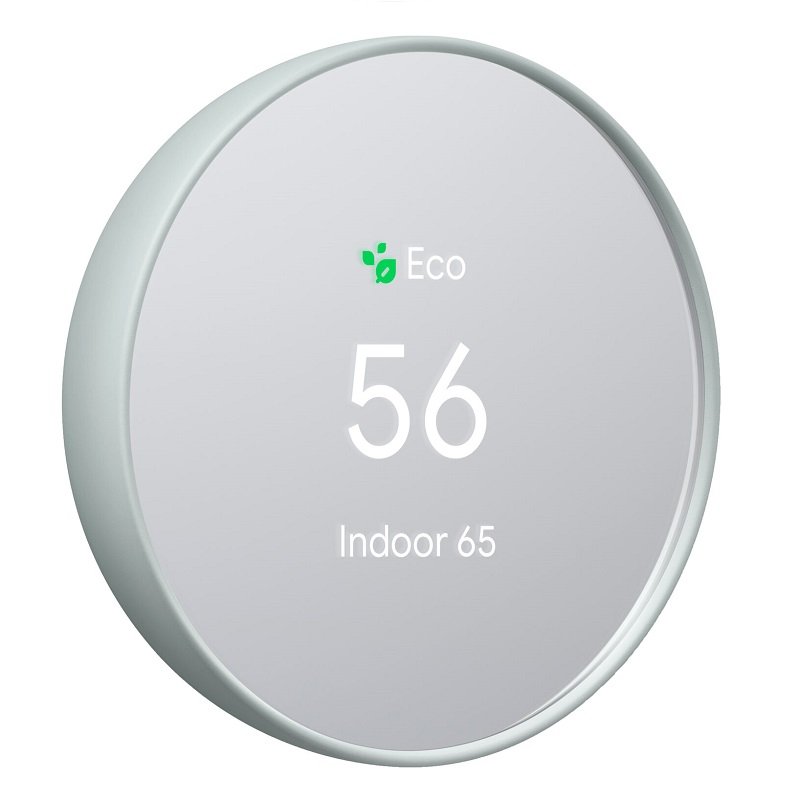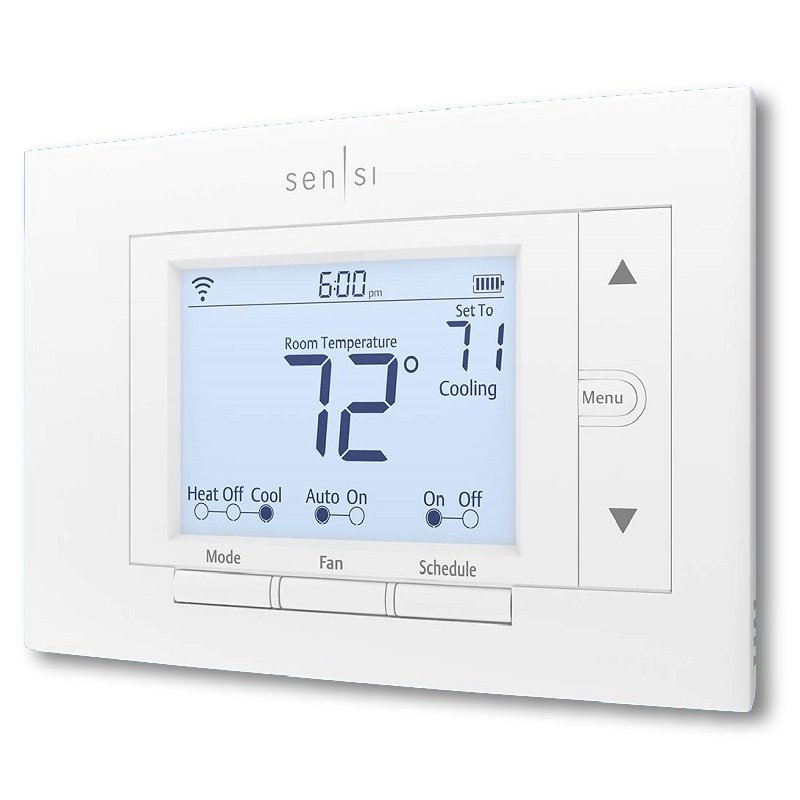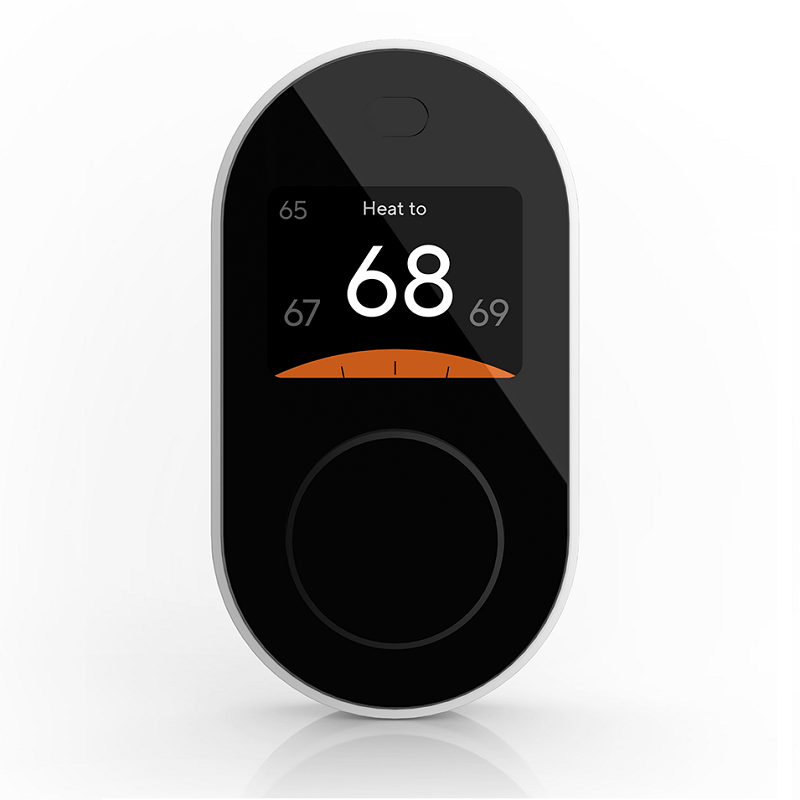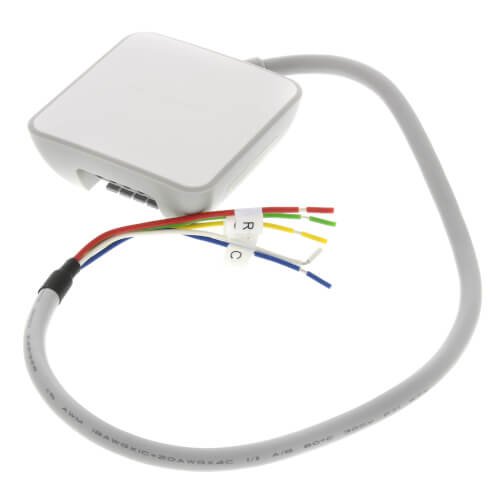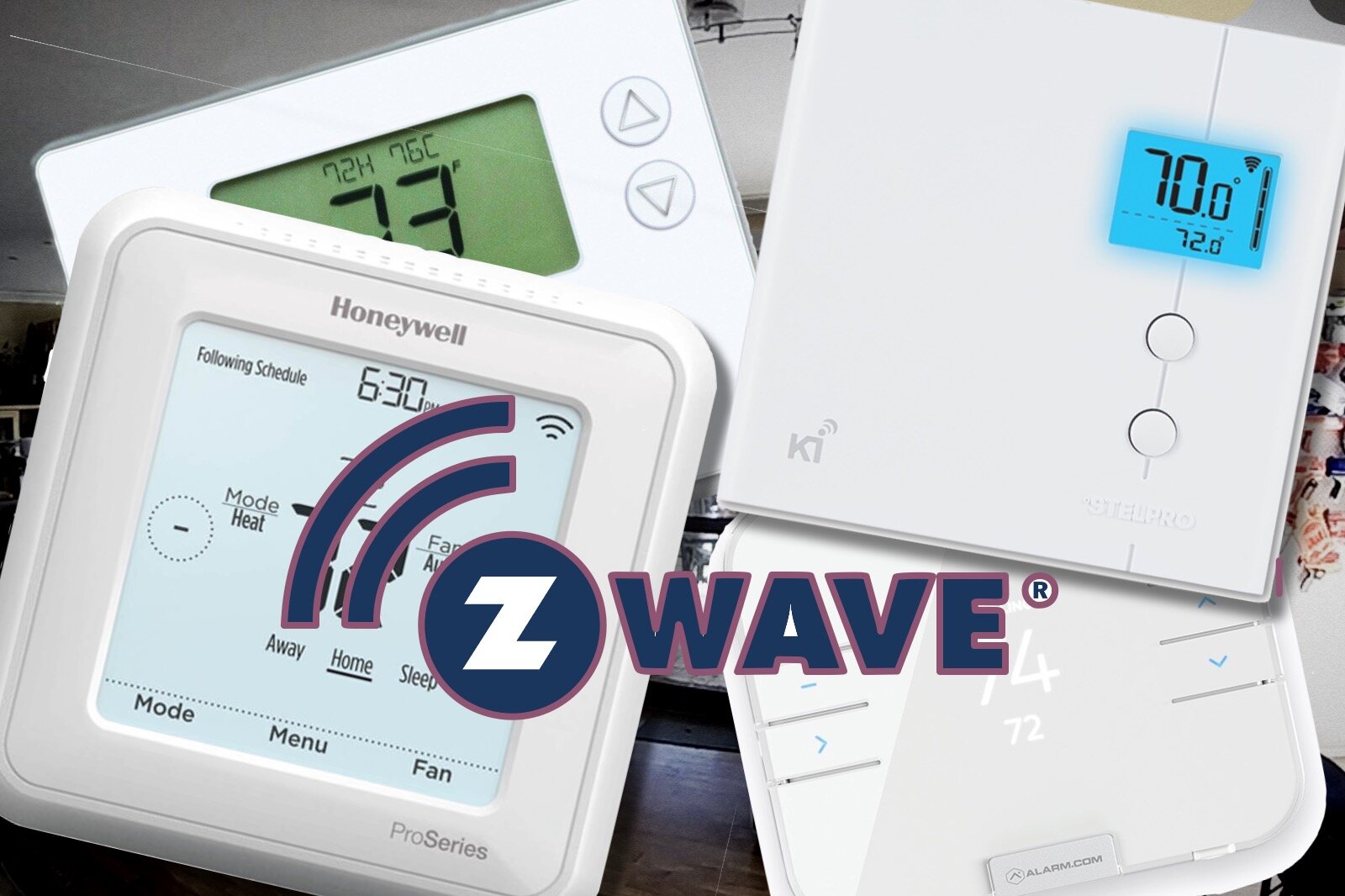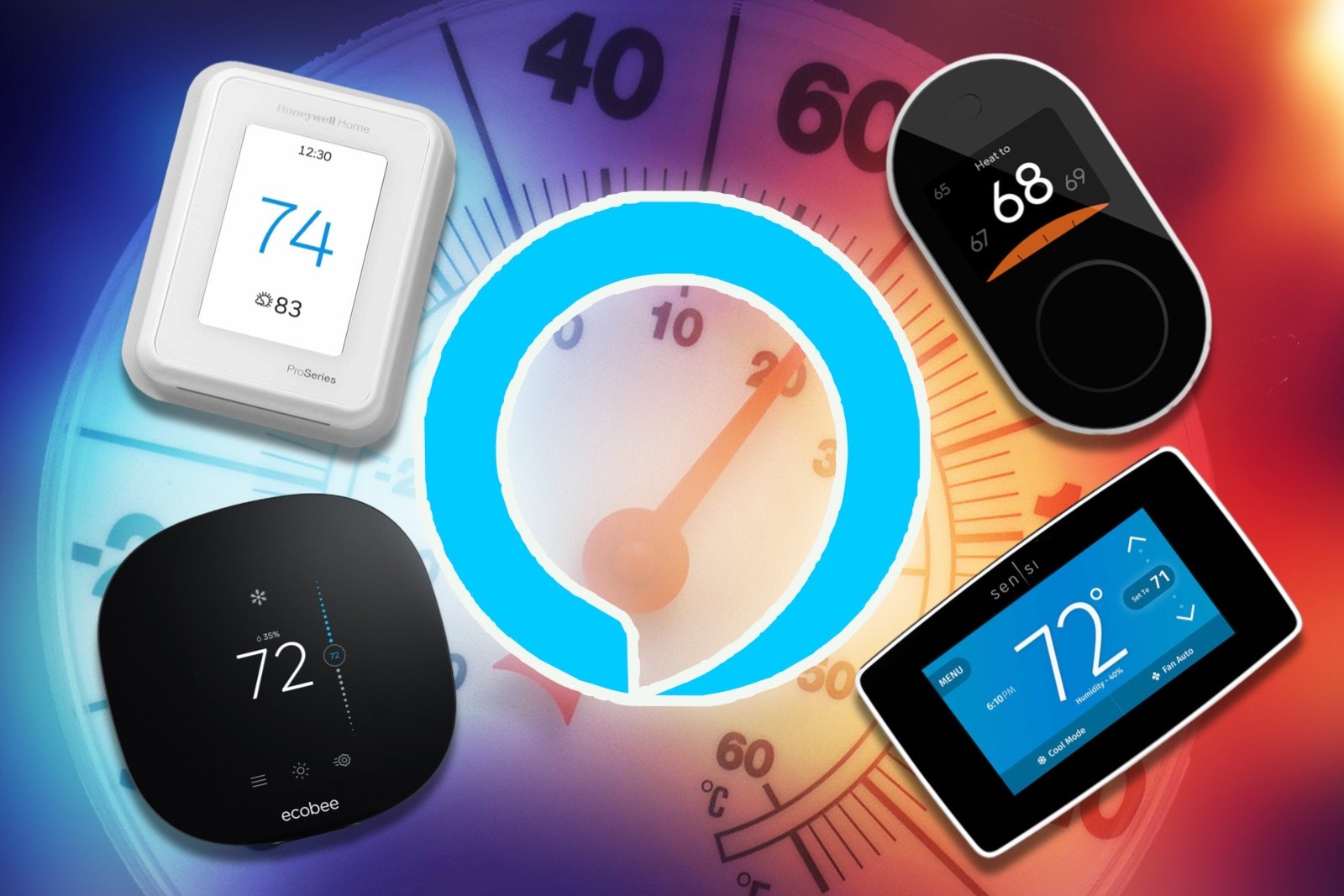Thermostats That Don’t Need A C-Wire
When you buy through links in this article, I may earn an affiliate commission. Learn More.
Smart thermostats can bring a lot of convenience to the smart home, but also deliver significant energy savings as well. These devices commonly require what’s known as a C-wire, but some homes may not have one. Don’t worry if you’re in this situation as there are options that will allow you to use a smart thermostat in most cases.
Running without a C-wire entirely requires that we provide another source of power to the thermostat. We can do that by getting a model that runs on batteries, or by using an external power adapter that plugs into a wall socket. There are also ways you can tap into power from your HVAC system without a dedicated C wire, depending on what wires you do have.
I’ve selected the best of the handful of smart thermostats on the market at the moment that offer some kind of work around for the c-wire issue. There are quite a few models than now offer an adapter, and there are various third-party c-wire adapters also available, but these still require some extra wiring that you may not have available.
For a true ‘no c-wire’ experience, you’ll need to look at one of the handful of battery-powered options available. Thankfully there are a few good options here.
My Top Picks for Going Without a C-Wire
Best Battery Model
Google Nest Thermostat
✔ Automated Energy Saving
✔ Dual Band Wi-Fi
✔ Multiple Finish Options
Best Budget Model
Sensi Lite
✔ Simple Controls
✔ No C-wire Required
✔ Easy install
Best Adapter Model
ecobee Smart Thermostat
✔ Best Smart Features
✔ Included C-wire adapter
✔ Included Room Sensor
What is a C-wire anyway?
Most thermostats are wired into the HVAC control board via a number of thin, colored wires. These thermostats are 24V low voltage devices that draw power from the control board of your heating or cooling system. The wire that delivers that return circuit for the thermostat itself is known as the C-wire, or Common wire.
Smart thermostats generally require one of these as they have higher power draw requirements due to the need to run on-board smarts, Wi-Fi radios, and fancy displays.
It’s important to note that the C-wire issue only applies to 24V (low voltage) thermostat systems. If you have a high voltage (line voltage) heating system like baseboard or in-floor heating, you’ll need what’s known as a line voltage thermostat. You can tell these by looking at the existing thermostat. There will be either 2 or 4 thick wires leading into the back, possibly joined with wire nuts, and there may be a label indicating 120V or 240V.
How do thermostats run without a C-wire?
There are three ways you can use a thermostat without a c-wire, and I have recommendations for each of these options below.
1) Run the thermostat on batteries
Using an internal rechargeable battery, or plain old AA or AAA batteries, a thermostat can maintain the power it needs to run its smarts without any external power source. The biggest issue here is limited power availability which can reduce the available features, and the need to replace them fairly often.
2) Use a ‘c-wire adapter’
Some smart thermostats come with a c-wire adapter. This is a small device that is wired into your HVAC control board and allows the thermostat to draw power via some of the other wires that you do have available. You’ll still need to have certain wires running to your thermostat, but these are the more common ones that will usually be available even if you don’t have the C-wire.
3) Use an external power pack
The last resort is to simply use a 24V AC power pack that plugs into the wall. This is wired into your thermostat wiring terminals the same as a c-wire would be and provides the same power. The downside with this approach is that it’s a bit unsightly as you have to run wires from the thermostat to a nearby power socket.
Battery Powered Options
Google Nest Thermostat
★★★★★
Best Option
• Supports Alexa and Google Home
• Dual band Wi-Fi - no hub
• Built in temperature sensors
• 24V C-Wire or Internal Batteries
• Easy install
• Energy star certified
What I Like
My top pick for a battery powered smart thermostat is the newest Google Nest Thermostat model. This is a simpler device than the Nest Learning Thermostat, which also means it’s less expensive. It can work with most simple 2 wire heating systems and includes a compatibility checker in the app that you can use before buying.
This uses a similar parasitic energy harvesting model to its more expensive brethren, which involves drawing power from the control circuit to charge an internal lithium-ion battery. But the new model also has a backup supply provided by two regular AAA batteries which you can easily replace as needed.
The display is a mirror finish for a more unique look, and the body comes in 4 different colors: Charcoal, Sand, Fog, and Snow. There are trim kits available in each color as well if you need to cover up holes from your old thermostat.
The Nest Thermostat offers fewer smart features than the Learning model, but still allows for automated energy saving based on presence (so it turns the heat down when no one is home, for example), and the setting of smart schedules to control things to your liking and routines. It’ll also monitor your HVAC system and send alerts for things you may want to look at, and helpful maintenance reminders.
You can share control with up to 10 family members, and the app will provide recommendations on tweaking settings to improve efficiency. Manual control is provided via a touch strip on the side of the casing. Simply slide up and down to adjust the temperature or tap to open the settings menu.
Potential Concerns
Being a simpler model, you won’t have the range of control options that more expensive units do. In this case it’s limited to only the basic 6 wires possibilities Y, C, W R, G, and OB. So that’s 1 stage of heating or cooling, an auxiliary function and a fan. Some functions are also disabled when running without a C-wire.
The energy harvesting system Google uses in these smart thermostats depend on the system being on in order to steal some of the power from the control board to charge the internal battery. If your system doesn’t deliver enough, or is turned off for too long, the internal battery can drain and fail to set your temperature when it should.
While it does have the AAA battery backup, you may find it problematic and need to look at giving it an alternative power source anyway. There are plenty of people who’ve found it given an error to that effect after a few months of usage.

✔ Multiple color finishes
✔ Easy installation

✘ Battery can drain if system if off regularly
✘ Not as many smart features as c-wire models
Sensi Lite ST25
★★★★✩
Budget Option
• Supports Alexa, Google Assistant, SmartThings
• 2.4GHz Wi-Fi
• With or without 24 V C-wire
• Easy Install
• Simple controls
• Energy star certified
What I Like
The Sensi Lite smart thermostat from HVAC company Emerson offers a good selection of popular smart home integrations. It works with three of the major smart home platforms - Alexa, Google Assistant and Samsung SmartThings as well, but HomeKit users miss out on this one. The older Sensi ST55, however, does support HomeKit.
While not offering a fancy color display, it’s clear and functional with easy-to-use controls on the face and a sleek, modern design. The simpler display has an advantage in that it can run without a c-wire in many installations. It does this by using a similar ‘energy sharing’ method to the Google Nest Thermostat. This takes energy from the HVAC system itself while it is operating to power the device. This works with conventional heating and cooling systems that include a Gas or Electric heater, boiler, and AC unit. Heating only and cooling only systems and heat pumps will still require a c-wire.
Installation is easy, and similar to the Nest approach where the mounting plate has the clearly labelled wire terminals adjacent to the hole which they pass through from the wall. It’s not quite as nicely laid out, and some people may find the wire terminals a bit tricky, but it’s essentially the same process. Being a more standard sized thermostat is also an advantage if you’re replacing an older unit as you won’t have any exposed hole in the wall needing to be covered over.
The smart phone app is one of the easier ones to use and guides you nicely through selecting and connecting the correct wires and terminals. There are no particular smarts here like you’ll find on the Nest, but you can define multiple schedules for different situations, get filter change reminders, usage reports to see where you’re spending money, and smart alerts to keep tabs on your HVAC system health.
The temperature sensors in these consumer devices can often have an offset as they’re not well calibrated, and unlike some other models, the Sensi allows you to program an offset of plus or minus 5 degrees to correct it for your room placement. This not only allows you to calibrate the sensor for better accuracy, but also gives you the option to deliberately offset it to account for placements where it doesn’t reflect the general temperature of the house.
Potential Concerns
One thing to note with the Lite model is that the screen is actually very basic. In order to save power, it’s a small LCD display in the center of the unit that just shows the current temperature and operating mode, not much else. The controls on the face are separate capacitive touch controls, not a touch screen display. This makes operation of the unit itself very simple, but many of the functions can only be accessed through the smart phone app.
I’ve seen a few reports of difficulty connecting to the Wi-Fi network during setup, and a few about it dropping out all the time. These reports are few, however, and seem to be related to older Android versions on the phone running the app. I haven’t experienced these issues myself.
Similarly, I’ve seen complaints about the documentation being lacking. While it certainly doesn’t cover every eventuality (and what setup documentation does?) it looked pretty comprehensive and easy to follow to me. I’m putting that one down to user error.
Finally, as the Sensi thermostats only support WPA2 Wi-Fi security you won’t be able to use WPA3 on your network if you want to use one of these. Most people won’t be using that yet, but it could be a deal-breaker if you are and want to keep that higher level of security on your network.

✔ Simple operation
✔ Easy installation

✘ Limited smart features
✘ Wi-Fi setup can be difficult
Emerson Sensi ST55
★★★★✩
HomeKit Option
• Supports Alexa, Google Assistant, HomeKit, SmartThings
• 2.4GHz Wi-Fi - no hub
• 24 V C-wire or AA Batteries
• Easy Install
• Energy star certified
What I Like
The Emerson Sensi ST55 smart thermostat offers a similar selection of popular smart home integrations with the addition of Apple HomeKit. While not offering a fancy color display, it’s clear and functional, with easy to use controls on the face.
The simpler display has an advantage in that it can run on only 2 standard AA batteries which can be easily replaced in the back. The batteries provide backup power in the event of a power interruption or allow you to run the device without a C-wire at all.
Installation is easy, as with the newer Sensi Lite brethren above, and will not leave you with any exposed wall damage to deal with. The physical manual controls, while looking a bit dated, are preferable for some people and I’ve seen cases of downgrading from the fancier Sensi Touch models to the old ST55 for a more tactile user experience.
Much of the configuration is done through the app, which is basic, but well presented. There are no particular smarts here, but you can define multiple schedules for different situations with up to 8 set points per day, as well as manual remote control via the internet.
The wiring options support 2 stage heating and cooling, with or without a heat pump, as well as heat pump aux and emergency heat modes, and a single stage fan control.
Finally, Emerson has included a control panel lock out function right in the app, so you can prevent kids, or guests, from messing with the settings. You could also opt to get finer control and set limits on specific settings by using the Sensi Manager subscription service, but you don’t need that for basic lockout functions.
Potential Concerns
There have been reports of poor Wi-Fi performance, with dropouts and units refusing to reconnect. There are enough of these that are similar to warrant noting it, but I’m also wary that all Wi-Fi smart devices have these complaints to some extent, usually due to poor Wi-Fi signal, or lousy consumer routers that are in common use. Your mileage will vary.
It’s worth noting that two AA batteries will not keep Wi-Fi running for long, so if you’re using it without a C-Wire you’ll be changing these more frequently, and when the power gets low the unit will disconnect the Wi-Fi in order to keep doing its job.
There is one more specific bug on this particular model where the thermostat will call for heating when it’s not required, or even when it’s turned off. Again, it’s a minority of cases, but it suggests there may be a connectivity issue with the wiring contacts between the back plate and the device in some cases.

✔ Simple operation
✔ Uses normal AA Batteries

✘ Poor support
✘ Can have Wi-Fi drop outs
Power Adapter Options
ecobee Smart Thermostat
★★★★★
Best Option
• Supports Alexa, Google Assistant, HomeKit, SmartThings, IFTTT
• Dual band Wi-Fi - ho hub
• 24V C-wire or included adapter
• Includes detached smart sensor
• Alexa built in voice control
• 3-year warranty
• Energy star certified
What I Like
Right now, the 3rd generation ecobee Smart Thermostat is the most feature packed smart thermostat that includes a C-wire adapter. In ecobee’s case they call it a PEK (Power Extension Kit). With an all black design concealing the extents of color touch screen, and a slick sharp interface highlighting the current temperature and HVAC mode.
You’ll get the most comprehensive smart home integration support, with the big three, plus SmartThings and IFTTT as well. Not only does it support Alexa, but it has Alexa (and now Siri) voice control built in along with Spotify integration and a microphone and speaker.
You can opt to disable that feature, or to mute the microphone as with Amazon’s Echo smart devices if you prefer. If you’re an Alexa user this is a nice bonus, giving you extra coverage for voice commands without needing to place another device in that area.
If you don’t care about using your smart thermostat as a smart speaker, and can do without some of the integrations that come with that, then you can also check out the ecobee3 Lite to save on the cost. You’ll get essentially the same smart thermostat otherwise.
The ecobee software allows for a wealth of flexible programming options such as being able to adjust the temperature thresholds, and thus the temperature spread of a given mode. You can configure upper and lower limits and allow the system to heat and cool as required, and there are many optional intelligent alerts for things like temperature and humidity limits, as well as potential system issues.
Scheduling is comprehensive, with the ability to set multiple schedules for different situations, and define the duration for home, away, and sleep modes. You can also set up Vacation mode that overrides the normal schedules for a set duration that you specify and uses custom settings for the time you are away.
The ecobee smart thermostat comes with a smart room sensor, which includes temperature and motion detectors. You can add more of these room sensors as you wish, and place them around the house. You can then tell the smart thermostat which ones to focus on, or use a combined average to control the temperature. The motion component allows the system to automatically switch to Away mode to save energy, but you can override this with Sleep mode, of geofencing on your phone.
Ecobee also offers door/window smart sensors, and these can be combined with the smart thermostats to detect when, say, a window has been left open and pause the HVAC operation. This is a nice addition that most other models don’t provide for. Be aware that this feature does require a subscription to ecobee’s Haven smart home system.
All of these smart features can be configured or disabled as you wish on the screen or in the ecobee app, providing a lot of control about how the system runs, and leaving you in more control of your comfort levels.
Installation is simple, and follows the DIY design of other consumer models like the Nest smart thermostats. A mount plate is attached to the wall over the wiring hole, and the wires pass through the middle. These connect easily to snap lock wire terminals positioned radially around the hole preventing any stretching or tangling to get each to the right place.
It supports 2 stage heating and cooling, as well as 2 stage heat and cool on heat pumps, with 2 stage aux heating, and single speed fan control. A single accessory (humidifier, dehumidifier, or ventilator) is also supported. You’ll need a C-wire for power, but in most cases where you don’t have one you can use the included (PEK) to tap power from the HVAC control board. You can check your compatibility with their handy checker.
Potential Concerns
There’s not a lot to complain about here, and ecobee gets pretty solid reviews all round. The main issue I’d call out is that the wealth of configuration options may be too much for some folks. If you love playing with gadgets, great. If you have complex configuration needs, great. But if you’re not tech savvy and don’t really need to mess around with all that, it can be overwhelming.
I’ve seen some complaints about the temperature setting interface, which is done by sliding your finger up and down the slider on the right of the display. some people find that fiddly to get the exact temperature they want, but for someone with normal mobility I don’t see it as difficult at all. If you don’t have a steady hand or good motor control, then it would be more difficult than tapping an up and down button.
The in-built Alexa feature is a cool value add for Alexa users, but be aware that it’s not a full Alexa integration. This is common for third party products, and I have the same issue with my portable JBL smart speaker, it’s just how Amazon rolls. You can issue commands and access music and such, but it’s not really intended for that. Don’t expect a great quality room speaker here.

✔ Includes air quality and smart sensors
✔ Extensive configuration and scheduling options

✘ Could be too much complexity for some
✘ Higher price tag
Wyze Smart WiFi Thermostat
★★★★✩
Budget Option
• Supports Alexa, Google Assistant, IFTTT
• Wi-Fi - no hub
• 24V with C-wire (or adaptor)
• Easy install
• Physical dial for easy adjustment
What I Like
For a much cheaper alternative without all the bells and whistles, we have the well designed Wyze Smart Thermostat. This unit also comes with a C-wire power adapter in the box and a comprehensive walk through on setting it up through the Wyze app on your smart phone.
Being a cheaper product you will find the materials and finish not up to the same standard as the more expensive brands, and you won’t find the wealth of smart features on something like Nest or ecobee smart thermostats. However, if you’re looking for an easy to install thermostat that can be controlled from your phone as well as Alexa or Google Assistant, then this may be all you need.
The installation follows a similar approach to the bigger players, with the wires coming into the mounting plate and connecting to the labelled terminal blocks above and below. This is made easier by the Wyze app which asks you for your system setup, which wires you have, and then tells you what to put where.
The smart thermostat supports conventional 2 stage heat and cool, 4 stage heat and 2 stage cool on heat pumps, one accessory, and works with any dual transformer combination.
For those wanting a simpler interface, Wyze delivers with a large easy to use physical dial (the lower part of the image above). Simply turn the dial to set your desired temperature on the display. In the app, you can also configure home, away, and sleep modes, and a simple 7-day schedule. There are also useful features such as sensor calibration being able to set a minimum run time to prevent over cycling, and a vacation hold function to disable the schedule while your away.
Potential Concerns
Being a new product on the market from a company without experience in this particular market, there are likely to be some growing pains both with hardware quality control and software. On the up side Wyze has a proven track record of learning from and improving any software issues with their products.
Support, as is often the case with other smart devices, is a bit lacking. There are plenty of complaints in this regard, but Wyze is certainly not alone in this area with many brands in this list having similar problems. There is a decent product guide available for this smart thermostat, and the Wyze app can step you through a lot of the common issues, but that won’t help if you have a faulty device.
The app features are also a bit limited, with things like the schedule function limiting you to a 5 degree window and geofencing being sometimes unreliable. These are the kind of things can hopefully be improved through software updates.

✔ C-Wire adapter included
✔ Easy to use manual control

✘ Poor Support
✘ Limited app features
Third-Party Thermostat C-Wire Adapters
Some brands offer add-on C-wire adapters for their specific brands of smart thermostats. These come from the likes of Google and Honeywell, and could work with other brands, but there's no support or guidance on doing so. Still, the generic offerings have very poor documentation and also no support, so you might be better off with a branded model anyway.
This Honeywell C-Wire Adapter will work with most 24V thermostats and gets around the lack of a c-wire in the same way as other proprietary adapters - by using the G and Y wires to carry the common load as well as their normal functions. The major limitation with these adapters is that you generally need a C terminal on your HVAC controller to use them. All they do is prevent the need to run extra wiring in the walls.
Using An External Power Supply
As these smart thermostats run on a 24V AC supply, you can actually use a common doorbell power supply to provide power in lieu of a C-wire. This simply involves plugging the power adapter into the wall nearby and running the wires back to the thermostat, plugging them into the terminals for the C-wire as normal.
Example wiring for a c-wire power supply
There are plenty of suitable power supplies on the market, but you’ll want to look for one that is going to last, and has a good length of cable to ensure you can reach whatever power socket you have available.
This one from Hotop rates very well and includes a nice long 16.5 ft cable and a whole bunch of cable clips to ensure you can run this neatly to where you need without issue.
While this seems like an easy solution to not having a C-wire, it is the least tidy. You’ll have the wires running from a wall outlet to the thermostat, probably out in the open unless you’re prepared to drill extra holes in the wall and run it through that way.
My Recommendations
While you’ll always get the best smart thermostat results with a C-wire - and you can always have one installed providing your HVAC system supports one - there are some options for when you don’t want to go that way - or can’t.
Powering your smart thermostat with batteries is one option, in which case the best available device is the Google Nest Thermostat as it is able to charge itself from the control system, while also providing backup power through replaceable standard batteries. This can give you the same benefits and reliability as using a C-wire with the easiest installation. Beware, however, that not all installations will work well with this model, and you may need a C-wire anyway in some situations.
Instead, and if your wiring permits, you can use a C-wire adapter of some kind. One of the best smart thermostats on the market comes with such an adapter right in the box, the ecobee Smart Thermostat. Going this way will give you the most comprehensive set of smart features and a slick user interface, plus you get a smart room sensor thrown in to allow for more accurate climate monitoring inside the home.
Finally, you can always use a 24VAC power adapter to power your thermostat directly. This approach will work with any smart thermostat but will leave unattractive wiring exposed without some extra effort and cost. It’s a good hedge in case the other methods don’t work out for you.

